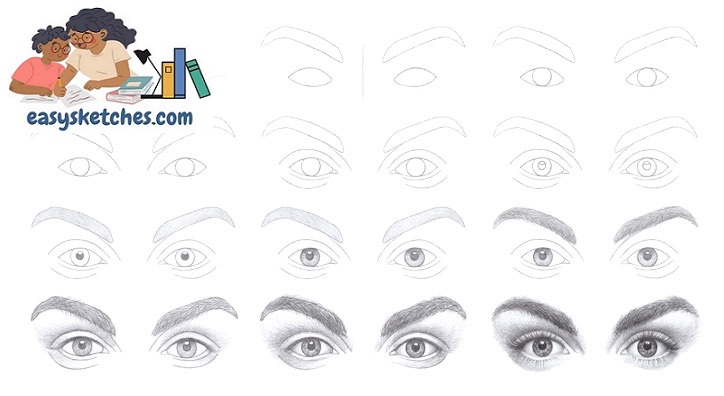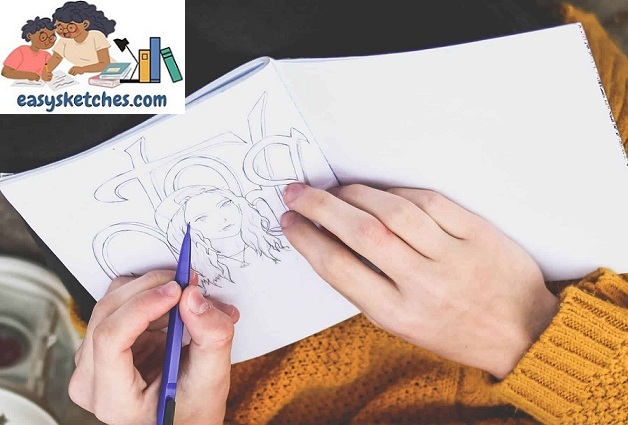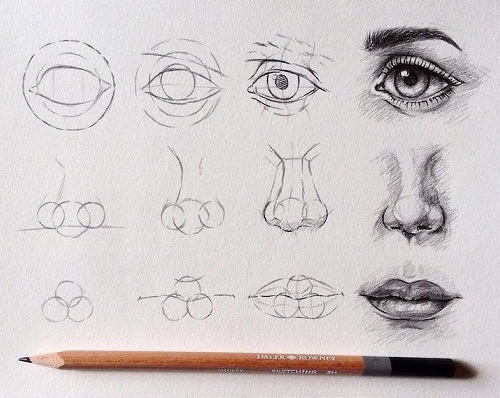Products You May Like
Experts share drawing tips to get you started and then move you forward

Drawing Tips
Collecting smorgasbord drawing tips can enable a change in your art. As most founders know, fear of a blank page can become quite natural, even the worst drawings that feel out of reach without some guidance.
To help you along the way, we’ve collected tips for drawing professionals from a wealth of experienced artists.
You will find all the steps you need to start on this page, but once you have been drawing regularly, you can jump to page 2 to understand how to build on your existing skills.
You may need technical guidance or just ways to get inspiration. In any case, we are confident that we have something to help you.
So prepare a sketchbook with pencils (see our guide to the best pencils and best drawing books if you need new ones), and get ready to learn about drawing.
Click the icons at the top right of the image to enlarge.

Know your pencils
There is a big difference between 4B and 4H
Having the right pencil to start drawing your pencil drawing is one of the essential drawing tips. Graphite hardness is shown on the side of the pencil:
‘B’ pencils are soft, ‘H’ are heavy, and ‘HB’ stays in the middle – there is a big difference between 4H and 4B. “I recommend starting somewhere on the H scale as a base and then finishing with a black B scale,” said traveling assembly artist Tim Von Rueden.
When learning to draw, you should also consider using machine pencils alongside the traditional ones. “Machine pencils are usually well articulated, while traditional pencils are ready to set large areas of texture,” said Von Rueden.
“Keep in mind that most machine pencils come with pre-installed HB, which only gives you a medium-range to work with.”
See the best machine pencils here.
Control your pencil
Tripod (top) and extended tripod (bottom)
“When you put your hand near the end of the pencil, you can control and be more precise, but you have heavy lashes (dark markings),” said photographer Sylwia Bomba. “Holding a pencil forward will give you control and less precision, but lighter lashes (light markings).”
For more tips, please read our article on how to hold a pencil correctly.
Try different ways of making marks
There are many ways to create a form within your drawings.
There are many drawing tips and tricks to help achieve different styles and effects. Above are some examples that show different ways of forming and depth.
“It’s important to try and find what works best for you, not only complementing but improving your style,” explains Von Rueden.
“While I like the smooth transition with pencil strips that meet the small frame, you can choose to divert the range brighter.”
Change your lines
Use a variety of lines, says photographer Rovina Cai. “Not all lines are the same. Subtle changes in the width and darkness of your lines will create powerful visual imagery. 6B) and holding a pencil at different angles. ”
Avoid fraud
Use an extra piece of paper under your hand to avoid crashing your work
“When you blur, use some paper under your hand,” advises artist Brun Croes. “This will reduce the amount of your hand melting your pencil lines.
If you have the right hand, start blurring from left to right; if you are on the left, begin request and go left.
“There is nothing more frustrating than trying to make a clean-cut painting that loses its splendor and expresses gratitude for melting.
Instead, use sharpening to gain regularity to make it smoother and darker. You can do this with a few tools. I use a piece of tissue paper to get the job done.”
Control your edges
Von Rueden uses four different drawing techniques to describe the edges of an object: thin, heavy, lost, and undefined. The delicate and sturdy edges give things a solid border.
Missing bites occur when an object and a background object begin to come together, so it is determined to be limited rather than defined.
Unspecified edges need to be seen by the viewer himself. He suggests exploring all four types and combining them to create interest within your work.
Use a mixing rod for a smooth shading
Create a subtle blur by capturing large areas of soft coal
You may have created smooth, compact effects using pencils – for example, to take the sky. “Sometimes it’s best to keep your shading as small as possible and smooth and subtle,” says singer Marisa Lewis. “Pencil lines do not fit well unless you are very careful.”
To avoid your first writing, Lewis uses a process – see more art here. “Use a separate sheet of paper to make a large doodle swatch of soft graphite or a charcoal pencil, and use a large mixing rod to pick up the soft dust that you will use for your photo,” she explains.
“Keep using a mixing stick and add as many words as you need more graphite.” After that, you can create dark spaces to create meaning.
Apply the 70/30 rule
Keep your focus point within 30 percent of the image.
One of the essential drawing tips is that a little can be more! The 70/30 rule helps you create functional songs. The idea is that 30 percent of your sketch is filled with crucial focus and details, and the remaining 70 percent is filled.
This less popular place helps direct you to the central theme of your art. You can see the application of the law in Von Rueden’s painting above.
Make (almost) equal
Keep the positive difference going between the finished look and the extra feel of the skirt.
“I like the accompanying paintings, but they usually look boring very quickly,” Croes said. “A good way to prevent this is to add subtle changes and keep the regular lines even rather than adding mirrors throughout the small section. Keeping other things out of balance helps to avoid boring duplication.”
Separate the different drawings
Consider whether what is essential is spicy or smooth and whether it absorbs or reflects light.
To show a different texture inside your cage, you need to adjust your process. “You wouldn’t want to sew leather in the same way that you cover metal or wool.
Each one has a different texture and texture that will enhance your designs because of the precision shown,” said Von Rueden.
A good start is looking at whether the texture is hard or smooth and whether it sucks or shows light. “The visible and smooth texture, similar to chrome, tends to have a high contrast and a bright contrast, while the soft and rough texture like cotton has a low contrast, and there is a little highlight,” he continued.
Master realism, then try something bright
Once you’ve mastered it, it’s easy to find a style that works for you
Drawings do not have to be realistic. However, Von Rueden believes that it is essential to focus on creating practical designs first – considering lighting, price, size, and body composition – before trying something bright.
“Once you understand how to replicate something, it’s straightforward to build the same kind of thing, especially creatures and characters,” he says.
“Over time, you will make seemingly small decisions, your own choices in making a piece (which is often lost in reality), and that is what will help you create your style little by little.”
Make the letters read like silhouettes
Here, it is clear that the first girl has a mug, but what about the second? Not so clear!
Character construction is a discipline, but this handy drawing technique is an excellent place to start. “Have you ever noticed that every important character in an animation game appears in his or her own shadow?” said singer Leonardo Sala. “This magic has a name: a silhouette.
The purpose of getting a strong and interesting image is to create an easily recognizable character that will remain vivid in the visual memory of the viewer.”
One of the best drawing tips is to see if your characters are recognizable by the type of silhouette. To do this, place a piece of drawing paper on your drawing and follow the trail around your character, filling it with a solid color. Then show a friend or co-worker, and ask what they see.
Make a difference
Differences can occur in hue, shape, texture, and more
The contrast helps direct the viewer’s eye inside the sketch. When people talk about comparisons, they often refer to the difference in value, where light and light in dark areas are emitted.
However, you can also create variations in hue, saturation, shape, texture, edges, proportions, and more.
“Great comparisons will need attention,” stressed Von Rueden. “I recommend putting the highest difference in your area where the focus is focused. You can also add differences to different forms and separate a different topic.”
But not everywhere
Areas with low contrast encourage the eye to move around
A variation is a powerful tool – but you can be tempted to make a big difference everywhere in your drawing, says Von Rueden. Hidden blurring can work the same way when it comes to displaying form and details.
“In the examples [above], you can see that a soft, low-key clip makes the eye move and does not define the focus area,” said Von Rueden. “While the focus
area of the comparison section is higher, it lies in a much darker darkness compared to the brightest lights.”
Flip your photo with tracking paper
If you spend a lot of time looking at a drawing, it can be challenging to see the flaws and where these drawing tips come from.
Artist Justin Gerard has some great drawing tips to help. “The advantage of tracking paper is that you can insert it to see what your drawing looks like on the back,” he advised. “This can help to point out errors evenly. As you work, use this to achieve the most successful drawing.”
Make the gradients work for you.
Gradients have an impact on where the viewer will look
Von Rueden is very fond of a well-placed rise. “They look good on the eyes and can direct the viewer’s attention to the focus area,” he noted.
“The width of the gradient is also essential. A slope covering most of the drawing or title will affect where viewers look, and small angles can add a pop of detail and contradiction. ”
Examine unfamiliar domains
“The use of unusual lines for coloring adds a lot of energy to your painting,” Bomba said. “If you want to create a new and unique image, architecture, or piece of art concept, you should try this approach.” Bomba uses it to add interest to low-lying areas.
Include imperfection
Make your things different, not just appearances.
“Instead of just looking at what makes something look like, you should also consider how you can make this thing different,” said Von Rueden. Quirks and imperfections can add character to your drawing, and it may raise the issue for the viewer to explore mentally.
In the example above, you can see three different carrots. The first one outlines what might come to your mind when you think of carrots.
The second is based on the actual carrot, with its lumps and bumps pressed to create sterilization. In the third, Von Rueden moved one step further. “Look at adding [imperfection] to anything and try to have fun by including it in something fun,” he said.
Enjoy the details
Von Rueden believes that the heart and soul of the artist are reflected in the details of the painting. “The extra time to put things that can be ignored is like the management of viewers who give themselves time to look for them,” he said.
Adding extra attention to detail can also teach you patience. “Good art should be developed, not made,” he adds. “Don’t ignore that information or let time be a barrier. Accept it!”
Trust your instincts
People are very responsive to work that sounds realistic
“Creating art requires courage. To fully express who you are, what you are interested in, how you feel, and what you stand for. Too many artists play it safe.
From experience, you find that a job that sounds real will meet people. “When you’re at the art level, trust your instincts and express your first drawings and icons,” he continues. “Don’t worry about the answer. Create without fear that it will be ‘fine’ or not.”
